

Grizzlies have a pronounced muscular hump on their backs, between their front shoulders, used to aid in digging for food or den construction. Finally, though it is much more common to see black bears climbing trees, grizzlies, especially cubs, may occasionally climb them as well!įortunately, bears have a number of easily identifiable characteristics which can be used to tell them apart. Droppings of black and grizzly bears are difficult to distinguish and vary widely depending on the type of food being consumed. Juvenile grizzlies have been mistaken for black bears and vice versa. Photo: Josh Mettenīody size is also an unreliable indicator. This is a tagged bear that is being studied by the NPS, as indicated by its ear tags. Also notice the short curved claws, straight face, and tall skinny ears characteristic of black bears. However, black bears are frequently observed in the parks with brown coats, see the photo below.Ĭinnamon Black Bear, Grand Teton National Park. It is not uncommon for both visitors and locals to observe a brown colored bear and assume it is a grizzly. Though close encounters with both species should always be avoided careful identification to distinguish the two can be helpful in avoiding conflict. Both grizzly and black bears are found in the Greater Yellowstone Ecosystem, and each has its particular challenges with coexistence.

Read on for more!įor years, people have journeyed to Grand Teton and Yellowstone National Parks to view the sights and wildlife, especially bears. Then we discuss ways to reduce and avoid conflict with our wild neighbors.
GRIZZLY ADVENTURE 2 HOW TO
In this two part series we first explore how to identify the difference between two of our large carnivores, black and grizzly bears. Coexistence and the reduction of conflict is becoming increasingly important as these animals come into closer contact with humans. Our large carnivore populations, including mountain lion, wolf, black bear and grizzly bear have rebounded to some of the highest levels in the last century. It is here that visitors have an opportunity to see the same animals which were here when the first European American explorers entered the area in 1807. The Greater Yellowstone Ecosystem is one of the most biologically intact temperate ecosystems left on earth. A boar grizzly emerges from the woods in Grand Teton National Park


 0 kommentar(er)
0 kommentar(er)
